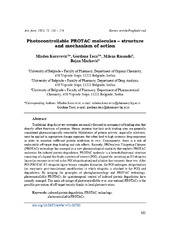Photocontrollable PROTAC molecules – structure and mechanism of action
Fotokontrolisani PROTAC molekuli - struktura i mehanizam dejstva
| dc.creator | Koravović, Mladen | |
| dc.creator | Tasić, Gordana | |
| dc.creator | Rmandić, Milena | |
| dc.creator | Marković, Bojan | |
| dc.date.accessioned | 2021-07-05T08:15:59Z | |
| dc.date.available | 2021-07-05T08:15:59Z | |
| dc.date.issued | 2021 | |
| dc.identifier.issn | 0004-1963 | |
| dc.identifier.uri | https://farfar.pharmacy.bg.ac.rs/handle/123456789/3918 | |
| dc.description.abstract | Traditional drug discovery strategies are usually focused on occupancy of binding sites that directly affect functions of proteins. Hence, proteins that lack such binding sites are generally considered pharmacologically intractable. Modulators of protein activity, especially inhibitors, must be applied in appropriate dosage regimens that often lead to high systemic drug exposures in order to maintain sufficient protein inhibition in vivo. Consequently, there is a risk of undesirable off-target drug binding and side effects. Recently, PROteolysis TArgeting Chimera (PROTAC) technology has emerged as a new pharmacological modality that exploits PROTAC molecules for induced protein degradation. PROTAC molecule is a heterobifunctional structure consisting of a ligand that binds a protein of interest (POI), a ligand for recruiting an E3 ubiquitin ligase (an enzyme involved in the POI ubiquitination) and a linker that connects these two. After POI-PROTAC-E3 ubiquitin ligase ternary complex formation, the POI undergoes ubiquitination (an enzymatic post-translational modification in which ubiquitin is attached to the POI) and degradation. By merging the principles of photopharmacology and PROTAC technology, photocontrollable PROTACs for spatiotemporal control of induced protein degradation have recently emerged. The main advantage of photocontrollable over conventional PROTACs is the possible prevention of off-target toxicity thanks to local photoactivation. | sr |
| dc.description.abstract | Tradicionalne strategije razvoja lekova su obično osvrnute na okupiranje vezujućih mesta koja direktno utiču na funkcije proteina. Stoga se proteini koji nemaju takva vezujuća mesta generalno smatraju farmakološki nedodirljivim. Modulatori aktivnosti proteina, naročito inhibitori, koriste se u režimima doziranja koji često dovode do preterane sistemske izloženosti leku, a sve u cilju održavanja dovoljne inhibicije proteina in vivo. Posledično, postoji rizik od neželjenog vezivanja leka van svog primarnog mesta dejstva i neželjenih efekata. Nedavno je predstavljena tehnologija dirigovane proteolize (PROteolysis TArgeting Chimera, PROTAC) kao novi farmakološki modalitet koji koristi PROTAC molekule za indukovanu degradaciju proteina. PROTAC molekuli su heterobifunkcionalne strukture sačinjene od liganda koji se vezuje za protein od interesa (POI), liganda za regrutovanje E3 ubikvitin ligaze (enzima uključenog u ubikvitinaciju POI) i linkera koji ih povezuje. Nakon formiranja ternarnog kompleksa POI-PROTAC-E3 ubikvitin ligaza, POI podleže ubikvitinaciji (enzimskoj post-translacionoj modifikaciji u kojoj se ubikvitin vezuje za POI) i degradaciji. Integrisanjem principa fotofarmakologije i PROTAC tehnologije, nedavno su nastali su fotokontrolisani PROTAC molekuli za prostorno-vremensku kontrolu indukovane degradacije proteina. Zahvaljujući lokalnoj fotoaktivaciji, glavna prednost fotokontrolisanih nad konvencionalnim PROTAC molekulima je moguća prevencija toksičnosti koja nastaje usled dejstva van primarnog biološkog targeta. | sr |
| dc.language.iso | sr | sr |
| dc.language.iso | en | sr |
| dc.publisher | Beograd : Savez farmaceutskih udruženja Srbije | sr |
| dc.relation | info:eu-repo/grantAgreement/MESTD/inst-2020/200161/RS// | sr |
| dc.relation | This research was funded by the Science Fund of the Republic of Serbia, Program DIASPORA (Grant No.: 6463913, Acronym: DeSyHPRO) | sr |
| dc.rights | openAccess | sr |
| dc.rights.uri | https://creativecommons.org/licenses/by-sa/4.0/ | |
| dc.source | Arhiv za farmaciju | sr |
| dc.subject | Induced protein degradation | sr |
| dc.subject | PROTAC technology | sr |
| dc.subject | photocontrollable PROTACs | sr |
| dc.subject | Indukovana degradacija proteina | sr |
| dc.subject | PROTAC tehnologija | sr |
| dc.subject | fotokontrolisani PROTAC molekuli | sr |
| dc.title | Photocontrollable PROTAC molecules – structure and mechanism of action | sr |
| dc.title | Fotokontrolisani PROTAC molekuli - struktura i mehanizam dejstva | sr |
| dc.type | article | sr |
| dc.rights.license | BY-SA | sr |
| dcterms.abstract | Марковић, Бојан; Коравовић, Младен; Рмандић, Милена; Тасић, Гордана; Пхотоцонтроллабле ПРОТAЦ молецулес – струцтуре анд мецханисм оф ацтион; Пхотоцонтроллабле ПРОТAЦ молецулес – струцтуре анд мецханисм оф ацтион; Фотоконтролисани ПРОТAЦ молекули - структура и механизам дејства; Фотоконтролисани ПРОТAЦ молекули - структура и механизам дејства; | |
| dc.citation.volume | 71 | |
| dc.citation.issue | 3 | |
| dc.citation.spage | 161 | |
| dc.citation.epage | 176 | |
| dc.citation.rank | M51 | |
| dc.identifier.doi | 10.5937/arhfarm71‐30785 | |
| dc.identifier.fulltext | https://farfar.pharmacy.bg.ac.rs/bitstream/id/9032/Photocontrollable_PROTAC_molecules_pub_2021.pdf | |
| dc.type.version | publishedVersion | sr |

